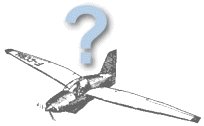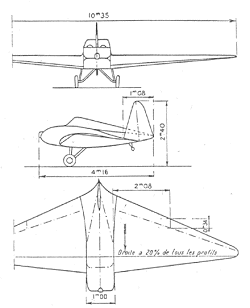 |
Why a flying wing ? |
How can one
come to understand the Fauvel flying wing formula as opposed to a more
classic formula? The complete answer to this question requires delving
deep into the inner workings of these machines. Summarized here are some
ideas that explain the advantages of this formula.
The stability of the "tailless flying machine" is often put into doubt. That is the way it is with many people, pilot or not, held back psychologically by the idea that an airplane cannot safely and with a sufficient margin of stability operate with no tail. Yet, the various flying wing machines created by Fauvel and other designers leave no doubt that such devices are no less stable than those of a more classic design. And that the added "tailless" advantages are not to be disregarded...
When you think of a classic airplane, endowed with a stabilizer at the rear, you must know that:
- the machine can stall,
- an accidental spin
can be triggered while turning within a narrow circle at
minimum speed,
- vertical
acceleration loads can become critical at high speed
in turbulence, and are amplified if the wing loading is
low,
- the biggest part
of the fuselage exists for nothing more than a link to
the tail of the aircraft, and adds nothing but weight for
no other apparent contribution.
In a Fauvel flying wing,
these constraints do not exist. Jim Marske, a creative
designer of this form of sailplane, expresses his
thoughts thus :
"When you see a flying wing take off for a flight,
do you think, what a brave man to fly such a
dangerous machine. Believe me, that is what I think
when I see a tailed sailplane go off on tow."
 Of all the fatal accidents
involving general aviation at least half happen too
frequently due to stalls and spins at low altitudes. In
the domain of motorless flight, a sailplane that is more
stall resistant is a considerable asset for the pilot who
wishes to exploit weak thermal conditions close to the
ground. The Fauvel flying wing has the ability to fly at
low speeds with confidence because
unexpected "stall breaks" translate into simple
up and down motion often referred to as
"porpoising". The tailless airplane is also
endowed with good penetration of rough air at high speeds
thanks to the reduced drag of the fuselage and the
absence of interactions with a stabilizer. The compactness of the
formula permits one to achieve much
lighter structures, simpler mechanical
interfaces and are cheaper to build.
Thus, rather than to strengthen the structure of the
device by the use of expensive material or by lowering
the margins of safety, one decreases the parts count of
the aircraft. In spite of popular thought, it is
necessary to accept the fact that the flying wing will be
the strongest structural design for a given weight. The
AV-36, for example, was calculated to have the
coefficient of 12 (number of G's before structural
failure) with a mass weight of only 225 kg!
Of all the fatal accidents
involving general aviation at least half happen too
frequently due to stalls and spins at low altitudes. In
the domain of motorless flight, a sailplane that is more
stall resistant is a considerable asset for the pilot who
wishes to exploit weak thermal conditions close to the
ground. The Fauvel flying wing has the ability to fly at
low speeds with confidence because
unexpected "stall breaks" translate into simple
up and down motion often referred to as
"porpoising". The tailless airplane is also
endowed with good penetration of rough air at high speeds
thanks to the reduced drag of the fuselage and the
absence of interactions with a stabilizer. The compactness of the
formula permits one to achieve much
lighter structures, simpler mechanical
interfaces and are cheaper to build.
Thus, rather than to strengthen the structure of the
device by the use of expensive material or by lowering
the margins of safety, one decreases the parts count of
the aircraft. In spite of popular thought, it is
necessary to accept the fact that the flying wing will be
the strongest structural design for a given weight. The
AV-36, for example, was calculated to have the
coefficient of 12 (number of G's before structural
failure) with a mass weight of only 225 kg!
Present techniques of computer analysis permits one to have no fear of the aerodynamic phenomena that governs the domain of flight of these tailless machines. Of course, it is not all about a magic formula, and it doesn't provide the answer for all kinds of applications. Like all aeronautical concepts, it is a compromise between different parameters. As it happens, the Fauvel flying wing presents a remarkable compromise between security, cost, performance and complication, well adapted to the present needs of general aviation and the sportsman. Think of all these advantages the next time you board an airplane or a conventional sailplane, or if you think about designing your own flying machine !
--- Translated into English by Noble Faubion (nfaubion@netzero.net) ---